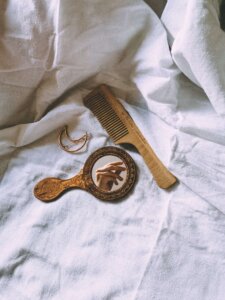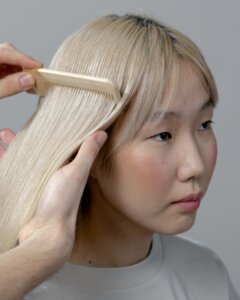Healthy Hair Habits

Brushing and combing are essential steps in our daily hair care routine. Yet, many of us are unaware that the way we handle our hair during these seemingly simple tasks can significantly impact its health and appearance. To ensure your locks stay strong, smooth, and lustrous, it’s crucial to learn the dos and don’ts of brushing and combing. In this beauty blog, we’ll guide you through the best practices for handling your hair with care, so you can achieve the gorgeous, flowing mane you’ve always dreamed of.
The Dos:
Do Choose the Right Brush or Comb:
Selecting the right brush or comb for your hair type is crucial. For detangling wet hair, opt for a wide-tooth comb to prevent breakage. Meanwhile, for dry hair, use a brush with natural bristles, which helps distribute your hair’s natural oils from the scalp to the ends, imparting shine and reducing frizz.
Do Start from the Ends:
Always begin brushing or combing from the ends of your hair and work your way upward. This approach minimizes tangles and knots, making it easier to detangle without causing unnecessary stress on your hair shaft. Gradually work through each section until you reach the roots, promoting a smoother, more seamless process.
Do Be Gentle and Patient:
Patience is key when it comes to hair care. Avoid rushing through the brushing or combing process, as this can lead to breakage and split ends. Instead, be gentle and patient, especially when dealing with knots. Use a detangling spray or a small amount of leave-in conditioner to ease the process and protect your hair from damage.
Do Brush or Comb Before Washing:
To prevent excessive hair breakage during shampooing, gently brush or comb your hair before getting it wet. This action removes tangles and knots, allowing the shampoo and conditioner to distribute more evenly, and reducing the chances of further tangling during the washing process.
Do Clean Your Brush or Comb Regularly:
Over time, hair products, oil, and dirt can build up on your brush or comb, which can transfer back onto your freshly washed hair. To keep your locks clean and healthy, make it a habit to clean your hair tools regularly. Use a comb or an old toothbrush to remove the residue, and wash them with mild soap and warm water.
The Don’ts:
Don’t Brush or Comb Wet Hair Vigorously:
Wet hair is more susceptible to damage as it is in a weakened state. Avoid brushing or combing your hair vigorously when it’s wet, as this can lead to excessive stretching and breakage. Instead, use a wide-tooth comb or a brush designed specifically for wet hair to gently detangle without causing harm.
Don’t Brush or Comb from the Roots:
Brushing or combing from the roots can put unnecessary stress on your hair follicles and scalp, leading to hair fall and damage. Start from the ends, as mentioned earlier, and gradually work your way up to avoid these issues.
Don’t Overbrush:
Brushing your hair excessively, especially with a poor-quality brush, can weaken the hair shaft and cause it to break. Be mindful of the frequency and intensity of brushing, especially if your hair is prone to dryness or damage.
Don’t Use a Poor-Quality Brush:
Investing in a high-quality brush or comb is a smart decision for the health of your hair. Cheap, plastic brushes with rough bristles can cause damage and friction, leading to breakage and split ends. Opt for brushes with natural bristles or those specifically designed for your hair type.

Conclusion:
Brushing and combing might seem like simple tasks, but they have a significant impact on the health and appearance of your hair. By following the dos and don’ts mentioned above, you can ensure that your hair care routine promotes strength, reduces breakage, and enhances the natural beauty of your locks. Remember to be gentle, patient, and invest in the right tools to handle your hair with care, resulting in a radiant and gorgeous mane that you’ll love to flaunt.




